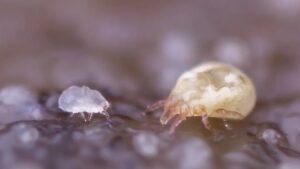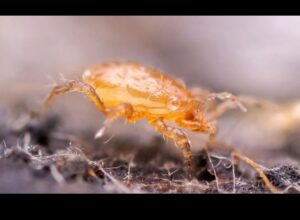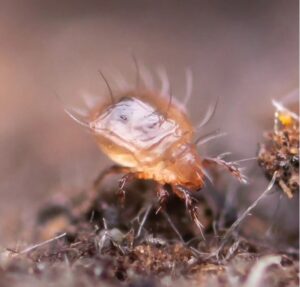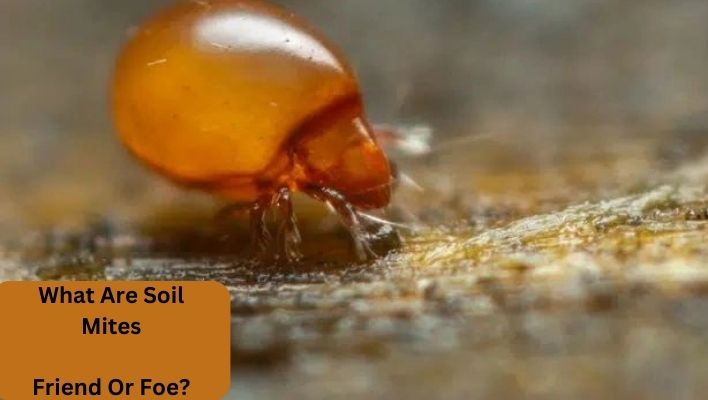The soil beneath our feet is teeming with life, a hidden world bustling with organisms that play crucial roles in maintaining the health and fertility of our planet.
Hidden beneath the surface, an intricate ecosystem thrives, where organisms play vital roles in maintaining the delicate balance of nature.
Among these underground inhabitants are soil mites, intriguing creatures that have sparked curiosity and debate among gardeners and nature enthusiasts alike. So, what are soil mites?
friend or foe? Are they friends, working tirelessly to maintain soil health, or foes, causing harm to plants and crops? These tiny arthropods may be small in size, but their impact on soil health and ecosystem functioning is immense.
Let’s embark on a journey to unravel the mysteries surrounding these tiny arthropods and uncover their true nature.
From their diverse forms and habits to their impact on soil health, we’ll delve into the fascinating world of soil mites and discover whether they should be welcomed with open arms or treated with caution.
Soil Mites Identification
Soil mites, classified as arthropods, are tiny creatures that belong to the larger group of mites known as Acari.
These minuscule arthropods are an integral part of the soil ecosystem, playing a significant role in nutrient cycling and soil health. They are different from root aphids.
One of the fascinating aspects of soil mites is their incredible diversity in terms of size, shape, and color.
These microscopic arthropods can vary in size from as small as 0.2 millimeters to several millimeters in length. As for their shapes, soil mites can be elongated, oval, or even round, depending on the species.
Additionally, they exhibit a wide range of colors, including white, brown, black, and various shades in between.
Such diversity in appearance reflects the adaptability and evolution of these tiny creatures, making them a truly remarkable component of the soil ecosystem.

Lifecycle and Habits
The lifecycle of soil mites is a fascinating journey that encompasses various stages of development. It begins with eggs, which are laid in the soil by adult mites.
These eggs hatch into nymphs, which are smaller and less developed versions of the adults. The nymphs go through several molts, shedding their exoskeletons as they grow, before reaching the final stage of adulthood.
When it comes to habits, soil mites engage in a range of activities that contribute to the functioning of the soil ecosystem.
One of their primary tasks is feeding, as they consume organic matter like decaying leaves, fungi, algae, and even other microscopic organisms.
By breaking down this organic material, they aid in the decomposition process and nutrient cycling within the soil.
Mating is another essential aspect of soil mite behavior. Adult mites typically engage in courtship rituals, which may involve intricate dances or exchanges of pheromones. After successful mating, the females lay their eggs in the soil, continuing the lifecycle.
In terms of movement, soil mites navigate through the soil using a combination of crawling and burrowing. Their small size allows them to explore the intricate spaces between soil particles, creating tunnels and pathways as they move.
This movement contributes to soil aeration and the formation of channels that facilitate water infiltration and root growth.
Types of soil mites
Soil mites encompass a diverse array of species, each with its unique characteristics and adaptations. While there are numerous types of soil mites, here are a few common ones:
- Oribatid Mites: Also known as “beetle mites,” oribatid mites are one of the most abundant groups of soil mites. They have a hard exoskeleton and are characterized by their slow-moving nature. Oribatid mites play a vital role in soil organic matter decomposition and are often found in the upper layers of the soil. Additionally, they contribute to soil structure through their burrowing activities, promoting aeration and water movement.
- Mesostigmatid Mites: Mesostigmatid mites are predatory mites that feed on other soil-dwelling organisms, including nematodes and smaller mites. They have a more active and aggressive lifestyle compared to other soil mites. These mites contribute to the regulation of pest populations and help maintain ecological balance in the soil. They serve as natural pest controllers, helping to regulate populations of harmful pests within the soil ecosystem.
- Prostigmatid Mites: Prostigmatid mites are generally smaller in size and have a more elongated body shape. Some species within this group are known as “soil surface mites” because they are often found in the top layer of soil or leaf litter. They contribute to the breakdown of organic matter and participate in nutrient cycling.
- Astigmatid Mites: Astigmatid mites are commonly associated with stored food and grains, but they can also be found in soil habitats. Some species are detritivores, feeding on decaying organic matter, while others are parasitic, preying on insects and other mites. They play a role in nutrient recycling and can impact pest populations.
- Prostigmata Mites: Prostigmata mites are a diverse group that includes various predatory mites. They are known for their role in controlling pest populations in the soil, such as plant-parasitic nematodes and other harmful soil-dwelling organisms.
These are just a few examples of the many types of soil mites found in different habitats worldwide. Each type has its ecological niche and contributes to the overall functioning and balance of the soil ecosystem.

Distribution and Abundance of Soil Mites
Soil mites can be found in various habitats around the world, from forests and grasslands to deserts and wetlands.
They are incredibly adaptable creatures and have managed to colonize diverse ecosystems, showcasing their global distribution.
Their abundance in healthy soil ecosystems is worth noting. Soil mites play a crucial role in maintaining soil health and functioning.
They are one of the most abundant and diverse groups of soil organisms. Their high population densities contribute to the overall biodiversity and ecological balance within the soil.
The importance of soil mites in healthy soil ecosystems cannot be overstated. Their activities promote nutrient cycling by breaking down organic matter and releasing essential nutrients back into the soil. This, in turn, supports the growth of plants and other soil organisms.
Moreover, soil mites aid in the decomposition process, accelerating the breakdown of dead plant material and facilitating the recycling of organic nutrients.
Their burrowing and movement within the soil contribute to soil structure and aeration, allowing for better water infiltration and root development.
Ecological Role of Soil Mites
One of the key ecological roles of soil mites lies in their contribution to the vital process of nutrient cycling within the soil. These tiny arthropods play a significant role in the decomposition of organic matter, particularly plant debris.
Soil mites are voracious eaters, feeding on a wide range of organic materials, including decaying leaves, dead plant roots, and other organic detritus.
As they consume this organic matter, they break it down into smaller particles, aiding in the process of decomposition.
Through their feeding activities, soil mites help to accelerate the breakdown of plant debris, facilitating the release of nutrients trapped within.
As the organic matter decomposes, essential elements such as nitrogen, phosphorus, and potassium are liberated, becoming available for uptake by plants and other soil organisms.
Furthermore, soil mites have a role in the fragmentation of organic material. Their movements and feeding activities create smaller particles, which increases the surface area available for microbial decomposition.
This enhances the efficiency of nutrient release and further supports the recycling of organic matter.
Soil Structure and Aeration By Soil Mites
In addition to their role in nutrient cycling, soil mites also have a significant impact on soil structure and aeration.
These tiny arthropods are adept at burrowing through the soil, creating intricate pathways as they move. This burrowing activity plays a crucial role in maintaining a well-structured soil environment.
As soil mites tunnel through the soil, they create channels and pores, which promote better water movement and infiltration.
These channels allow water to penetrate the soil more efficiently, reducing the risk of surface runoff and soil erosion. Improved water movement also helps to prevent waterlogging, ensuring optimal soil moisture levels for plant growth.
Moreover, the burrowing activities of soil mites contribute to soil aeration. By creating passages and air pockets within the soil, they enhance the exchange of gases between the soil and the atmosphere.
This promotes oxygen diffusion into the soil, providing a favorable environment for beneficial soil microorganisms and plant roots.
The impact of soil mite burrowing goes beyond aeration and water movement. Their tunneling activities help to improve soil structure by loosening compacted soil and reducing soil density.
This results in improved soil porosity and increased space for root growth. The channels created by soil mites also facilitate root penetration and the establishment of a robust root system, which is essential for plant nutrient uptake and overall plant health.
Predation and Pest Control
In the hidden realm of the soil ecosystem, some soil mites have evolved to become formidable predators, feeding on harmful pests such as nematodes.
These predatory soil mites play a crucial role in regulating pest populations naturally.
Nematodes are microscopic worms that can cause damage to plant roots and disrupt the overall health of plants.
However, certain species of soil mites have adapted to this environment by developing predatory behaviors. They actively hunt and consume nematodes, acting as natural enemies and helping to keep their populations in check.
The predatory soil mites employ various strategies to capture and feed on nematodes. Some mite species use their long, slender mouthparts to pierce and suck the body fluids of their prey, while others immobilize nematodes by entangling them in sticky silk threads before devouring them.
By preying on nematodes, these soil mites play a vital role in pest control within the soil ecosystem. They help to regulate nematode populations, preventing them from reaching damaging levels that can harm plants.
This natural form of pest control is an important component of maintaining a balanced and healthy soil ecosystem.
The presence of predatory soil mites serves as a biological control mechanism, reducing the reliance on chemical pesticides and promoting sustainable farming practices.
It underscores the significance of preserving and enhancing the diversity of soil mites in agricultural and natural systems, as they contribute to the suppression of harmful pests, ensuring the well-being of plants and the overall health of the soil ecosystem.
Interactions and Relationships
Symbiotic Associations:
In the intricate world of the soil ecosystem, soil mites form mutualistic relationships with various other soil organisms, fostering beneficial interactions that contribute to the overall health and functioning of the ecosystem. Two notable examples of such symbiotic associations are mycorrhizal fungi and nitrogen-fixing bacteria.
-
Mycorrhizal Fungi:
Mycorrhizal fungi form a mutualistic relationship with plant roots, and soil mites can play a role in this symbiosis.
Mycorrhizal fungi establish a network of fine, thread-like structures called hyphae, which extend into the soil and enhance nutrient uptake for plants.
Soil mites, through their burrowing activities, can help facilitate the spread and establishment of mycorrhizal fungi by dispersing their spores or hyphal fragments.
In return, the mycorrhizal fungi provide the plants with increased access to nutrients, such as phosphorus and nitrogen, which are essential for plant growth and development.
-
Nitrogen-Fixing Bacteria:
Some soil mites also have mutualistic associations with nitrogen-fixing bacteria, such as those of the genus Rhizobium.
These bacteria have the remarkable ability to convert atmospheric nitrogen into a form that plants can utilize.
Soil mites can aid in the dispersal and colonization of nitrogen-fixing bacteria by carrying them within their bodies or through the movement of soil particles.
In return, the bacteria provide the soil mites with a source of nitrogen, contributing to their nutritional needs.
These mutualistic relationships between soil mites, mycorrhizal fungi, and nitrogen-fixing bacteria demonstrate the interconnectedness of the soil ecosystem.
By facilitating the establishment and functioning of these beneficial associations, soil mites contribute to the nutrient availability and overall health of plants.
These symbiotic interactions highlight the complexity and interdependence of the soil community, where different organisms work together for mutual benefit, ultimately promoting the sustainability and productivity of the soil ecosystem.
Interactions with Plants
Soil mites play a significant role in influencing plant growth and health through their impact on nutrient availability, seed germination, and root development. Let’s explore how these interactions occur:
- Nutrient Availability: Soil mites contribute to nutrient cycling and availability in the soil. As they feed on organic matter, they break it down into smaller particles, facilitating the release of essential nutrients. This process helps to enrich the soil with nutrients that are vital for plant growth, such as nitrogen, phosphorus, and potassium. By improving nutrient availability, soil mites indirectly support plant growth and contribute to the overall health of plants.
- Seed Germination: Soil mites can influence the process of seed germination. Some mite species aid in the breakdown of seed coatings or seed dormancy mechanisms, promoting faster and more successful germination. They create favorable conditions for seedling establishment by enhancing soil moisture retention, promoting seed-soil contact, and facilitating nutrient availability. Additionally, soil mites can help disperse seeds by transporting them through the soil, contributing to the colonization and dispersal of plant species.
- Root Development: Soil mites can have a direct impact on root development. Their burrowing activities create channels and pores in the soil, providing pathways for root growth. These tunnels also improve soil structure, reducing soil compaction and promoting root penetration. The presence of soil mites can stimulate root branching and enhance root proliferation, resulting in a more extensive and efficient root system. A robust root system, in turn, improves nutrient and water uptake, leading to healthier and more vigorous plant growth.
Soil mites influence plant growth and health through their role in nutrient availability, seed germination, and root development.
Their contribution to nutrient cycling enriches the soil, promoting optimal conditions for plant growth. They aid in seed germination by breaking seed dormancy and providing suitable germination conditions.
Additionally, their burrowing activities create favorable soil structures for root development, enhancing nutrient and water uptake.
These interactions highlight the importance of soil mites in supporting plant growth and maintaining the overall health of plant communities in the soil ecosystem.

FAQ
How can soil mites be beneficial?
Soil mites offer several benefits to the soil ecosystem. They contribute to nutrient cycling by breaking down organic matter and releasing essential nutrients, promoting healthy soil fertility.
Their burrowing activities improve soil structure and aeration, enhancing water movement, reducing compaction, and creating favorable conditions for root growth.
Some soil mites are predatory, feeding on harmful pests like nematodes, and providing natural pest control.
Additionally, soil mites aid in seed germination and contribute to the dispersal of beneficial organisms such as mycorrhizal fungi.
Are soil mites harmful to humans?
Generally, soil mites are not harmful to humans. They are tiny arthropods that primarily reside in the soil and have no direct impact on human health.
Soil mites are not parasitic and do not transmit diseases to humans. However, in rare cases, some individuals may experience skin irritation or allergic reactions when in contact with certain mite species.
It is essential to practice good hygiene and wear protective gloves when working with soil to minimize potential irritation or allergies.
Can soil mites be controlled or eliminated?
Soil mites are an integral part of the soil ecosystem and cannot be eliminated.
However, in certain situations where specific mite species pose a problem, such as in agricultural settings, cultural practices and management strategies can help control their populations.
These include implementing crop rotation, maintaining proper irrigation and drainage, optimizing nutrient management, and using biological control agents like predatory mites. It is important to note that the goal is to achieve a balance rather than complete elimination, as soil mites have important ecological roles.
How can you encourage soil mite populations in your garden?
To encourage soil mite populations in your garden, it is important to create a favorable habitat for them. Here are some practices that can help:
- Organic Matter: Add organic matter such as compost or well-rotted manure to the soil. This provides a food source for soil mites and supports their population growth.
- Avoid Overuse of Chemicals: Minimize the use of chemical fertilizers and pesticides, as they can harm soil mites and disrupt the ecological balance. Opt for organic and natural alternatives whenever possible.
- Mulching: Apply organic mulch on the soil surface to maintain moisture, regulate temperature, and provide habitat for soil mites.
- Minimize Soil Disturbance: Avoid excessive tilling or digging, as it can disrupt soil mite populations. Instead, practice no-till or reduced tillage methods to preserve their habitat.
- Provide Shelter: Create habitat diversity by incorporating plant diversity in your garden. Different plant species can support various soil mite species by providing shelter, food, and niches for their activities.
Conclusion
Soil mites are fascinating creatures that play crucial roles in the soil ecosystem. From nutrient cycling and decomposition to pest control and promoting soil structure, these tiny arthropods have a significant impact on the health and productivity of the soil and the plants that depend on it.
Through their burrowing activities, soil mites enhance soil aeration and water movement, creating pathways for root growth and facilitating the exchange of gases.
They contribute to the breakdown of organic matter, releasing essential nutrients and enriching the soil with the building blocks of life.
Additionally, some soil mites act as natural predators, helping to regulate pest populations naturally and maintaining a balance within the soil ecosystem.
Understanding the importance of soil mites and their ecological roles is essential for sustainable agriculture and ecosystem management.
By implementing practices that support soil mite populations, such as adding organic matter, minimizing chemical use, and preserving habitat diversity, we can foster healthy and thriving soil ecosystems.
Soil mites, though often unseen and underestimated, are vital players in the hidden world beneath our feet. They remind us of the interconnectedness and complexity of the natural world.
By nurturing and appreciating these tiny creatures, we can contribute to the preservation of healthy soils, sustainable food production, and the overall well-being of our planet.
